In this article, You will read the Wind Energy in India & Wind Power Plants – UPSC.
Wind Energy
- Wind energy is the kinetic energy associated with the movement of atmospheric air. Wind turbines transform the energy in the wind into mechanical power, further converting it to electric power to generate electricity.
- Wind energy is an important source of renewable energy in India. Many of the largest operational onshore wind farms are located in the United States, India, and China.
- Five nations – Germany, USA, Denmark, Spain, and India – account for 80% of the world’s installed wind energy capacity.
- How it works
- Wind energy conversion devices like wind turbines are used for converting wind energy into mechanical energy. Wind turbines consist basically of a few sails, vanes, or blades radiating from a central axis. When the wind blows against the blades or vanes, they rotate about the axis. This rotational motion is utilized to perform some useful work. By connecting the wind turbine to an electric generator wind energy can be converted into electric energy.
- It is quite efficient as compared to a heat engine.
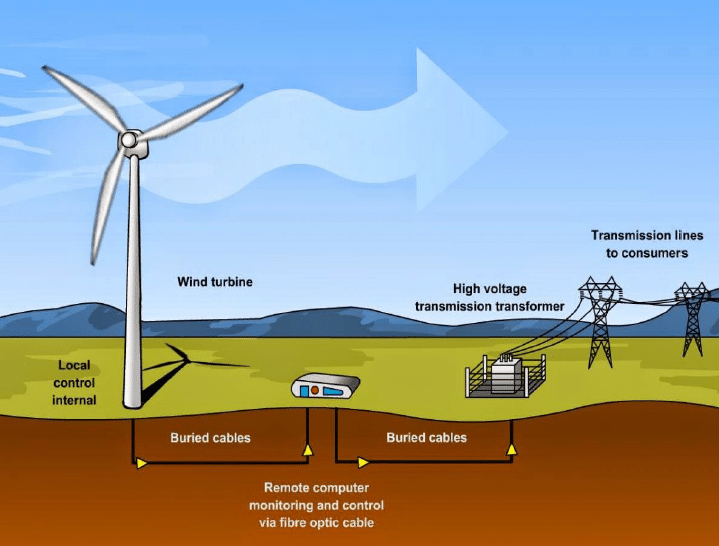
Wind Farm/Park
- A wind farm or wind park, also called a wind power station or wind power plant, is a group of wind turbines in the same location used to produce electricity. Wind farms vary in size from a small number of turbines to several hundred wind turbines covering an extensive area.
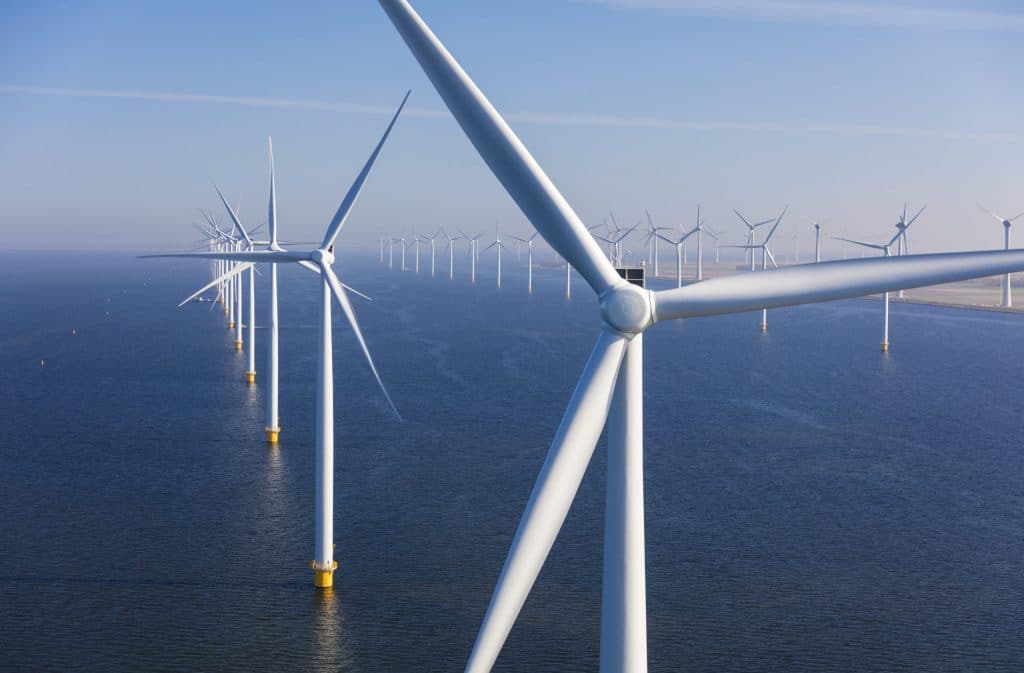
Types of Wind Farm/Parks
- Onshore – Wind turbines harness the energy of moving air to generate electricity. Onshore wind refers to turbines located on land.
- Offshore – offshore turbines are located out at sea or in freshwater.
- A fixed-foundation turbine is built in shallow water, whereas a floating wind turbine is built in deeper waters where its foundation is anchored in the seabed. Floating wind farms are still in their infancy.
- Offshore wind farms must be at least 200 nautical miles from the shore and 50 feet deep in the ocean.
- Offshore wind turbines produce electricity which is returned to shore through cables buried in the ocean floor.
Advantages of Offshore Wind:
- Windmills can be built that are larger and taller than their onshore counterparts, allowing for more energy collection.
- They tend to be far out at sea, meaning they are much less intrusive to neighbouring countries, allowing for larger farms to be created per square mile.
- Typically out at sea, there is a much higher wind speed/force allowing for more energy to be generated at a time.
- There are no physical restrictions such as hills or buildings that could block the wind flow.
Disadvantages of Offshore Wind:
- The biggest disadvantage of an offshore wind farm is the cost. Offshore wind farms can be expensive to build and maintain and because of their hard to reach locations, they are susceptible to damage from very high-speed winds during storms or hurricanes which is expensive to repair.
- The effect of offshore wind farms on marine life and birds are not yet fully understood.
- Offshore wind farms that are built closer to coastlines (generally within 26 miles) can be unpopular with residents as it can affect property values and tourism.
Advantages of Onshore Wind:
- The cost of onshore wind farms is relatively cheap, allowing for mass farms of wind turbines.
- The shorter distance between the windmill and the consumer allows for less voltage drop off on the cabling.
- Wind turbines are very quick to install, unlike a nuclear power station, which can take over twenty years, a windmill can be built in a matter of months.
Disadvantages of onshore Wind:
- One of the biggest issues of onshore wind farms is that many deem them to be an eyesore on the landscape.
- They don’t produce energy all year round due to often poor wind speed or physical blockages such as buildings or hills.
- The noise that wind turbines create can be compared to as the same as a lawnmower often causing noise pollution for nearby communities.
Working of wind turbines
- Wind turbines convert the kinetic energy in the wind into mechanical energy. This mechanical power can be used for specific tasks (such as grinding grain or pumping water) or a generator can convert this mechanical power into electricity. Most turbines have three aerodynamically designed blades.
- The energy in the wind turns two or three propeller-like blades around a rotor that is connected to the main shaft, which spins a generator to create electricity. Wind turbines are mounted on a tower to capture the most energy. At 100 feet (30 meters) or more above ground, they can take advantage of the faster and less turbulent wind.
- Three main variables determine how much electricity a turbine can produce:
- Wind speed – Stronger winds produce more energy. Wind turbine generates energy at a speed of 4-25 metres per second.
- Blade radius – The larger the radius of blades, the more the energy produced. Doubling the blade radius can result in four times more power.
- Air density – Heavier air exerts lift on a rotor. Air density is a function of altitude, temperature and pressure. High altitude locations have low air pressure and lighter air so they are less productive turbine locations. The dense heavy air near sea level drives rotors faster and thus relatively more effectively.


Status of Wind Energy in India
- India’s wind energy sector is led by the indigenous wind power industry and has shown consistent progress. The expansion of the wind industry has resulted in a strong ecosystem, project operation capabilities, and manufacturing base of about 10,000 MW per annum.
- The country currently has the fourth-highest wind installed capacity in the world with a total installed capacity of 39.25 GW (as of 31st March 2021) and has generated around 60.149 Billion Units during 2020-21.
- The compound annual growth rate for wind generation has been 11.39% between 2010 and 2020, and for installed capacity, it has been 8.78%.
- According to the Ministry of New and Renewable Energy (MNRE), India can generate 127 GW of offshore wind energy with its 7,600 km of coastline. According to the National Institute of Wind Energy (NIWE), the total wind energy potential is 302 GW at a 100-meter hub height.
- More than 95% of commercially exploitable resources are located in seven states: Andhra Pradesh, Gujarat, Karnataka, Madhya Pradesh, Maharashtra, Rajasthan and Tamil Nadu.
- Union Ministry of New and Renewable Energy (MNRE) has set a target of installing 5 GW of offshore wind energy by 2022 and 30 GW by 2030.
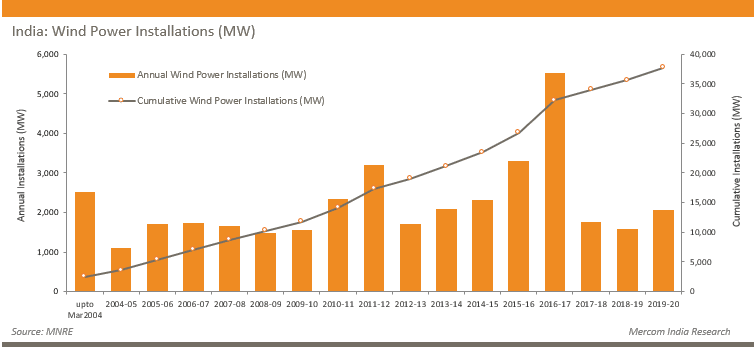
Policies related to Wind Energy
- National Wind-Solar Hybrid Policy: The main objective of the National Wind-Solar Hybrid Policy, 2018 is to provide a framework for promotion of large grid connected wind-solar PV hybrid systems for optimal and efficient utilization of wind and solar resources, transmission infrastructure and land.
- National Offshore Wind Energy Policy: The National Offshore wind energy policy was notified in October 2015 with an objective to develop the offshore wind energy in the Indian Exclusive Economic Zone (EEZ) along the Indian coastline of 7600 km.
National offshore wind energy policy-2015
- The government of India in its interest to develop offshore wind farm has decided to have a policy that will enable optimum exploitation of offshore wind energy in the best interest of the nation and to achieve the following objectives.
- To explore and promote deployment of offshore wind farms in Exclusive Economic Zones (EEZ) of the country including those under Public Private Partnership.
- To reduce carbon emissions by switching to offshore wind energy farms for harnessing the wind to generate electricity on a large scale.
- To promote investment in energy infrastructure and achieve energy security.
- To promote spatial planning and management of the offshore renewable energy resources in the exclusive economic zone of the country through suitable incentives.
- To encourage indigenization of the offshore wind energy technology.
- To promote research and development in the offshore wind energy sector.
- To create a skilled workforce and employment in the offshore wind energy sector.
- To facilitate the development of Project EPC (Engineering, Procurement, and Construction) and Operation & Maintenance concerning the offshore wind industry.
- To develop as well as maintain the coastal infrastructure and supply chain to support heavy construction & fabrication work and the Operation & Maintenance (O&M) activities in the offshore wind energy sector.
Maritime Zones
- There are two main maritime areas in which structures such as offshore wind farm can be built.
- Indian territorial waters, which generally extends up to 12 nautical miles(nm) from the baseline
- Exclusive Economic Zone (EEZ), beyond the 12 nautical miles(nm) limit and up to 200 nm, where under international law, India has right to construct structures such as wind farm installations.
- National Institute of Wind Energy (NIWE) will act as the Nodal agency for the development of offshore wind energy in the country.
Problems in the Wind Energy Sector
- For the past three years, there has been a lull in the wind power sector. In 2016-17, India added around 5.5 GW; in 2017-18, it came down to 2 GW.
- Initially, the growth in the wind energy sector picked up because of the incentives in generation, accelerated depreciation and taxation. The Government has gradually taken these incentives away.
- The lowest bidding price in solar energy is Rs 2.23 per unit whereas in the wind energy, it is about Rs 4.50. Investors find investment in the solar energy sector more lucrative.
- Policies related to wind energy being still in the transition phase.
- The Government of India came with the framework with respect to auctioning in December 2017. There is a ceiling of tariff imposed on every auction. Winds being region-specific, achieving the particular tariff rate becomes difficult.
- General challenges with respect to distribution companies (discom risks), for instance, curtailment in power generation, delayed payments to energy producers, etc.
Challenges in Harnessing Offshore Wind Energy
- Offshore entails lot of data collection before one actually ventures into it. For instance, Germany before it started its first few projects, took eight years of time to collect the metocean data and the geological data.
- For producing wind energy from offshore, a lot of investment is required in developing the support infrastructure.
- Higher Installation Cost: Local substructure manufacturers, installations vessels and trained workers are lacking in India. Offshore wind turbines require stronger structures and foundations than onshore wind farms. This can cause higher installation costs.
- Higher Maintenance Cost: The action of waves and even high winds, particularly during storms or hurricanes, can damage wind turbines. Eventually, offshore wind farms require maintenance that is more costly and difficult to perform.
- Presently, Europe is the leader in offshore. The tariffs there is equivalent to what India’s onshore tariff is. Europe’s offshore wind energy was supported over the years by incentives. Such a support is missing in India.
- There is a concern that who would put money on offshore given the production of solar energy right now being so cheap and onshore wind sector itself not as developed.
Way Forward
- Renewable purchase obligation: Power distribution companies, open access consumers and captive users can purchase clean energy as part of their total electricity consumption through a renewable purchase obligation.
- Lower taxes: In India, the GST Law exempts electricity and power sales from GST. In contrast, wind power generation companies cannot claim input tax credits when they pay GST to purchase goods and/or services for setting up the project.
- Feed-in tariff: Discoms can adopt feed-in tariff (FiT) regulations and make offshore wind power procurement mandatory. FiT can be tailored to suit each offshore wind project. FiT can be used to promote offshore wind power in the early stages of development until it becomes economically viable.
- Deemed generation provision: Offshore wind projects need to be protected against curtailment concerns because of the inability of State Load Dispatch Centres (SLDCs) to absorb large quantities of power that may be generated. For this, the offshore wind can be given a “deemed generation provision”.
- Develop sub-sea substations: The underwater power evacuation and subsea substations could be developed by the Power Grid Corporation of India Ltd. This would reduce the risk faced by offshore wind farm developers.
List of 10 Largest Wind Power Plants in India
| Wind Power Plant | Megawatt (MW) | Location |
| Muppandal wind farm | 1500 | Tamil Nadu, Kanyakumari |
| Jaisalmer Wind Park | 1064 | Rajasthan, Jaisalmer |
| Brahmanvel wind farm | 528 | Maharashtra, Dhule |
| Dhalgaon wind farm | 278 | Maharashtra, Sangli |
| Vankusawade Wind Park | 259 | Maharashtra, Satara District. |
| Vaspet | 144 | Maharashtra, Vaspet |
| Tuljapur | 126 | Maharashtra, Osmanabad |
| Beluguppa Wind Park | 100.8 | Beluguppa, Andhra Pradesh |
| Mamatkheda Wind Park | 100.5 | Madhya Pradesh, Mamatkheda |
| Anantapur Wind Park | 100 | Andhra Pradesh, Nimbagallu |
Top States in India – Installed Wind Power Capacity
- Tamil Nadu – Tamil Nadu tops the list of states with the largest installed wind power generation capacity in the country. Share of wind power in electricity generation was around 28% in 2018. Total wind capacity at the end of 2018 stood at 8,631 MW while its total installed electricity generation capacity stood at 30,447 MW at the end of 2018.
- Gujarat – Gujarat houses the second-largest installed wind power generation capacity in the country. Share of wind power in electricity generation was around 19% in 2018.
- Maharashtra – Maharashtra houses the third-largest installed wind power generation capacity in the country.
- Karnataka – Karnataka houses the fourth-largest installed wind power generation capacity in the country.
- Rajasthan – Rajasthan houses the fifth-largest installed wind power generation capacity in the country. Wind contributes around 20% of total electricity generated in the state.
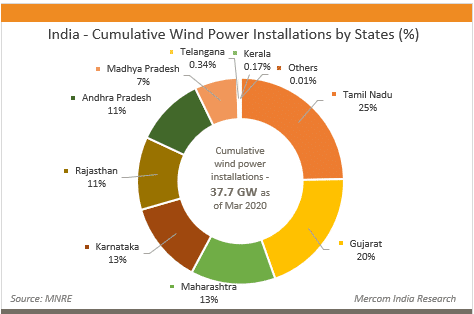
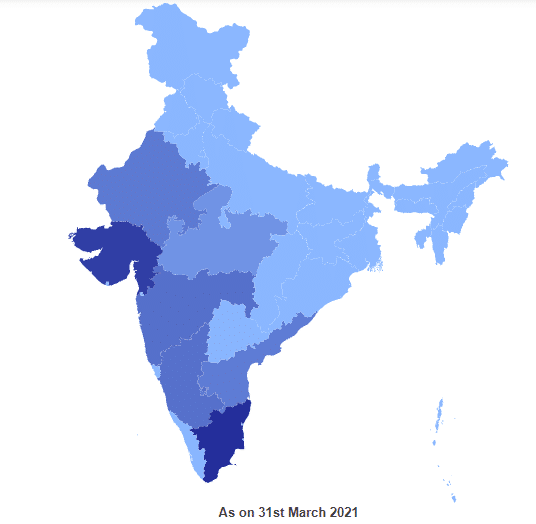

THANK YOU SIR ITS REALLY HELPFUL ALL YOUR ARTICLES IS WONDERFUL
ONCE AGAIN THANK YOU SIR FOR THE HELP WHO CAN’T AFFORD COACHING
Really these notes are very helpful.👍
Thank a lot .